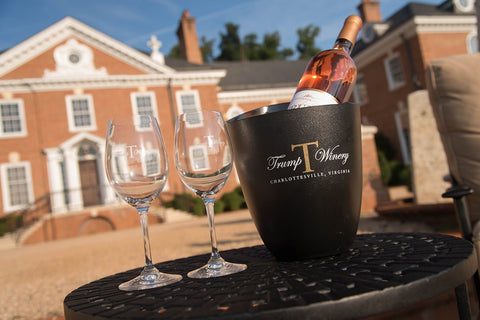Updated October 23, 2024
Nestled in "horsey" Charlottesville, Virginia as described by Vanity Fair, Trump Winery has emerged as a formidable player among the Commonwealth's more than 300 wineries. In this entry we take a deeper dive into the winery's history compared to our overview from a few months back. We delve into the transformative journey from the Kluge era to the Trump era, shedding light on the controversies and changes that have shaped its identity.
The Kluge Era
The roots of Trump Winery can be traced back to the vision of Patricia Kluge, a woman of affluence and ambition. In 1999, Kluge, along with her third husband, embarked on a mission to establish a winery with aspirations of producing the finest wines globally. Their estate, featuring a 45-room mansion, expansive vineyards, and idyllic landscapes, became a symbol of grandeur and opulence.
Financial Struggles and Trump's Intervention
Kluge's spare-no-expense approach to the winery included paying French wine consultants obscene sums so she could realize her dream of producing wine with the same cachet as those of Medoc icons. The winery under the Kluge name was initially successful. The Kluge red blends ,precursors to Trump's, earned critical acclaim, placement in the hottest restaurants and even managed their way onto the menu for Chelsea Clinton's wedding reception. Maybe this early success got to Patricia's head. Unfortunately the tens of millions she poured (wine pun, too easy) into her passion project by taking out several loans and even mortgaging the mansion did not pay off.
The winery's decline under her ownership stems from a couple of reasons. Apparently, high on all the buzz the winery was generating, she ramped up production. She quickly learned that demand was not as strong as she thought to warrant the added supply. While wine started to sit what really weighed on the winery's finances were her development dreams. She took out loans to expand the estate to build private multimillion dollar residences with pools, outdoor kitchens and vineyards to grow your own grapes if winemaking is your thing. As we all know, timing is everything and unfortunately this effort coincided with the subprime mortgage crisis of 2008. Like all the extra wine she made the houses she built were not going to sell in this environment. She eventually defaulted on her loans to Bank of America but not after reaching out to an old friend who was also one of America's most famous real estate tycoons.
Enter Donald Trump, who stepped in after Patricia called him asking to buy the property aware of how fond Trump was of the estate upon a visit. But as Trump famously quipped to a gallery owner while shopping for art with an interviewer in the late 90's, "I like this painting but I'm Trump and I never pay the asking price," and he was not going to start by paying what Patricia was asking.
Trump's Acquisition
The winery was initially listed by Sotheby's for $100 million but ended up selling for a fraction in foreclosure. Most reports rely on a sale price of $16 million dollars. Bank of America rejected several low ball offers from Trump. Trump had a two prong approach to eventually take ownership. While he was testing Bank of America with low ball offers to find their bottom he also began acquiring all the property surrounding the estate. According to political strategist Dick Morris who was privy to Trump's intricate maneuvering to acquire the property for as little as possible, Trump and his lawyers acquired every square inch of property surrounding the estate right up to the front door. Of course the Kluge estate had right-of-way easements but as it was at the time if you wanted to get inside the Kluge mansion to use the bathroom you needed to go through Trump. In another stunt to deter any would-be buyers Trump let the grass grow high on his surrounding parcels to sully the Kluge estate's picturesque views. In the end, Bank of America would finally accept an offer from Trump and the entire Kluge estate was folded into the Trump Organization.
Changes Post Sale
Patricia Kluge was initially appointed as the winery's director as a goodwill gesture by Trump. A year after her appointment Trump fired her in what one would assume Apprentice show style fashion. Questions surrounding the low purchase price, the firing of Kluge, and the overall business practices have marked the winery's narrative. Patricia concedes that while the winery may be managed in a way that she does not approve that the estate's gardens and vineyards have been impeccably maintained.
Trump Winery Today
Under the stewardship of Eric Trump, the son of Donald Trump, the winery continues its operations. Visitors can explore the impeccable landscapes, indulge in tastings, and even stay in the converted mansion turned hotel. However, the controversies surrounding the winery's past, its association with the Trump family, and the changes implemented post-acquisition linger in its history.
Final Note
Trump Winery stands as a testament to the intertwined worlds of wealth, ambition, and controversy. From Patricia Kluge's lofty aspirations to Donald Trump's strategic acquisition, the winery's journey reflects the dynamics of the wine industry and the influence of key players. As it continues to operate, Trump Winery invites visitors to explore its storied past while sipping on the wines that have become part of its intriguing legacy. However there are no tours. What a surprise.




Comments (0)
There are no comments for this article. Be the first one to leave a message!